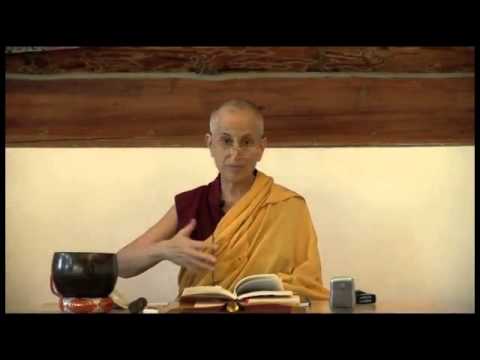Samsara or cyclic existence
A Bodhisattva Breakfast Corner commentary on the subject of cyclic existence.
I got an email from one of the people who’s doing the SAFE course. I think she’s doing Course 2. She was getting confused because she didn’t understand what the difference between samsara and cyclic existence was, and so I realized that maybe this wasn’t really clear in Course 1 or Course 2. It’s important to make it clear. They’re the same thing. Samsara is the Pali and Sanskrit word that is translated as cyclic existence.
Cyclic existence refers principally to our five aggregates, our body and mind that we take repeatedly under the influence of ignorance and afflictions. Sometimes we hear people talk about samsara as if it’s the external world. Now it’s true that the things in our external world are also created to a large extent by our ignorance and our afflictions, but they aren’t the problem. When we talk about renunciation and getting out of samsara or getting out of cyclic existence, it doesn’t refer to flying away from the world and rejecting everything and so on and so forth. It refers to stopping the ignorance that propels the afflictions that create the karma that throw us into rebirth after rebirth after rebirth in a body and mind that are under the influence of afflictions and karma. That’s having that freedom, that’s nirvana. Renunciation—which can also be translated as the determination to be free, it means the same thing—that’s the aspiration of the wish to be free from samsara.
I’m sorry if there was any confusion about this in the SAFE program, but I hope it’s good that we got that cleared up. Are there any questions about samsara or cyclic existence and how to get out of it? Well actually, before the question of how to get out, we need to ask ourselves why should I want to get out? I think one of our big problems is that we don’t want to get out. I mean our teachers have very often taught us the methods to get out, but we’re kind of hanging out with sense pleasure and all the good stuff that we’ve got right now, not realizing how impermanent and transitory it is, how confining and limited it is, that it’s under the influence of afflictions and karma. We don’t see that part. We think, “Oh, body is beautiful. Body is the source of my happiness. Okay, it gets old and sick and dies, but I’ll pretend that doesn’t happen, and I’ll just concentrate on eating delicious food and having a good sex life and going out with my friends and enjoyment.” I think that the big thing for us is to really ask ourselves, “Why should I want to get out?” That’s why we meditate a lot on the disadvantages of cyclic existence.
Audience: inaudible
Venerable Thubten Chodron (VTC): I think her question is all of our questions, which is that we see the disadvantages of cyclic existence, but we also watch ourselves get fascinated by all the good things in cyclic existence. How do we learn to say no to those good things without becoming so rigid that we’re the total opposite of what a spiritual practitioner should be? This is a very good question, and it’s something we all wrestle with.
My thought on this, because I deal with this too—the attachment, the laziness and all—is that my understanding of the defects of samsara is up here (pointing to head). There’s some of it in here (pointing to heart), and that amount that’s in here has enabled me to do what I’ve been able to do so far. But why am I distracted? Why am I lazy? Because my understanding is still basically intellectual, and the only way to really get a deep understanding of the disadvantages of cyclic existence is to repeatedly meditate on the three types of dukkha, the six types, the eight types, all the different afflictions, the twelve links and how ignorance creates afflictions, creates karma, creates suffering and to really do this again and again and again. It’s only by habit and repetition that we’re able to get from an intellectual understanding into something that really motivates us in our heart. There’s no shortcut to that. How is it that we feel something? It’s through habit, through familiarity. The intellectual understanding alone is a good step, but it doesn’t have the same power that the familiarity does.
I find that very often reading the Pali sutras, where the Buddha talks very much about the disadvantages of cyclic existence, that that’s very effective. I especially find the simile of the leper very effective when I meditate deeply on that. The leper who cauterizes his fingers and limbs and so on, to stop the incredible pain from the leprosy, but in doing so causes more damage to his body, which creates more pain and to see how basically I’m in the same thing. I run after the sense pleasure to try and stop my suffering. In the process I get entangled in more situations that create more pain. I find that example really something that makes me sit up, “I don’t want to be like that leper. That technique doesn’t work.” We have got to put energy into the meditation about this.
Venerable Thubten Chodron
Venerable Chodron emphasizes the practical application of Buddha’s teachings in our daily lives and is especially skilled at explaining them in ways easily understood and practiced by Westerners. She is well known for her warm, humorous, and lucid teachings. She was ordained as a Buddhist nun in 1977 by Kyabje Ling Rinpoche in Dharamsala, India, and in 1986 she received bhikshuni (full) ordination in Taiwan. Read her full bio.


